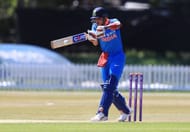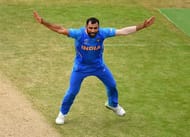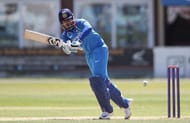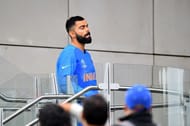
Authoritative cricket in the initial stages of the tournament, one standout performer who overcomes all the challenges posed by the oppositions. A resolute performance towards the business end of the tournament, yet falling short by a few steps.
Unfortunately, this trend of 'so close, but so far' has been persisting for India in the ICC tournaments for some years now. From the 2014 World T20, India have been consistently making it to the semi-finals of all the ICC events.
However, they have not been able to cross the knockout stages, leading to huge disappointment among fans and in the process, posing serious questions in the minds of the captain and team management.
While India have been the most consistent team in the world in the past few years, winning bilateral series on all kinds of turfs across formats, things just do not seem to go in favour of Men in Blue at the global events.
There are a few shortcomings, which have been consistently exploited in the knockout games. Here is a look a four possible changes that can be made to turn the fortunes in India's favor.
Note: The views of the author need not necessarily reflect the views of Sportskeeda.
#4 Drafting a specialist batsman into the middle order

The Men in Blue have been facing the middle order conundrum since the last World Cup held in 2015. They have been excessively reliant on the top 3 in Rohit Sharma, Shikhar Dhawan and Virat Kohli to deliver the goods. Apart from these three, the onus has been on MS Dhoni to deliver the goods, given his wealth of experience.
A great number of permutations and combinations have been tried to fix the middle muddle, but one error that has remained constant is that very few out of the selected individuals are regular batsmen. Predominantly, the middle order has seen the presence wicket-keepers and all-rounders such as Rishabh Pant, Dinesh Karthik, Kedar Jadhav, Vijay Shankar and Hardik Pandya.
While all the above-mentioned names are good players, they seem to be better suited in the shoes of a finisher. India requires technically sound quintessential batsmen to be drafted into the side, who can be trusted to anchor the innings in any situation.
Conventionally, every team has at least five regular, technically sound batsmen to provide solidarity to the department. This has been the characteristic of most of the teams in this World Cup, and also of the Indian squad in the previous decade.
Sachin Tendulkar, Gautam Gambhir, Virender Sehwag, Sourav Ganguly, Rahul Dravid and Yuvraj Singh were some of the iconic batsmen who ensured that that the Indian batting remained a force to reckon with.
While the addition of wicketkeepers and all rounders is not essentially a bad idea, emphasis must be laid on the fact whether they have the technique and temperament to anchor the innings. In the context of the Indian scenario, players like Mayank Agarwal, Shubhman Gill, and Shreyas Iyer can be given a go in the middle order.
#3 Consistency in strategy

Captain Virat Kohli, along with the team management has laid emphasis on dissecting the tasks into small parts and allocating them to particular individuals. However, the execution seems to be missing, which has been quite contradictary to the game plan.
For instance, Dinesh Karthik had asserted some days back that the team allotted a very specific role to him, which is to finish the innings. However, the first semi final saw him walk at No.5, at a precarious situation when India were staring down the barrel at 5-3.
Similarly, Kohli had claimed in the game against Australia that Mohammad Shami would be given a go when the conditions would be overcast. However, despite picking 14 wickets in 4 matches, Shami was not picked for the semi final against New Zealand at Manchester, where the conditions were overcast ahead of the game.
This inconsistent approach seems to be persisting in the team for quite some time now. Another fact to testify this is the exclusion of Ravichandran Ashwin in the league game against Pakistan in Champions Trophy 2017, wherein Kohli said that he played three pacers as the Pakistan batsmen were good at facing spin.
However, the final between the same two sides saw Ashwin drafted into the playing XI, and he went wicketless, giving away 70 runs from his 10 overs.
It would be prudent for the team to adopt and follow a strong strategy, and more importantly, be consistent in its execution, so as to seize the big moments in big games.
#2 Backing the young players

Rome was not built in a day. Similarly, it is not possible for players to transform overnight, and play match defining knocks for their country. However, if the players are backed, with technical and more importantly, emotional support, they can certainly mature into match winners.
This has been the pattern in the evolution of match winners like Yuvraj Singh, Virender Sehwag, Suresh Raina and Rohit Sharma, who received the support from their captains Sourav Ganguly and MS Dhoni.
In the test squad, senior performers like Cheteshwar Pujara, Ajinkya Rahane and Bhuvneshwar Kumar have been wary of their place in the squad. Ravindra Jadeja has also been kept out of the squad despite convincing performances.
Ambati Rayudu, who was being groomed for the No.4 spot for the World Cup, was ruled out in favour of Vijay Shankar on the basis of just one series. However, this is just the tip of the iceberg. The list also comprises of the likes of Shreyas Iyer and Manish Pandey, who were once the contenders for the No.4 spot.
It becomes imperative for the captain and team management to back the young players n every way possible, so as to extract maximum productivity from them and groom them for the future.
#1 Out of the box captaincy

Innovation is the pre-requisite for leadership. It enables the leader to bring in dynamism in his approach to guide his team members in a turbulent environment. In a game like cricket, it becomes even more necessary, considering the exogenous factors such as the pitch and the weather that come into play.
ICC tournaments have a rich legacy, which has been decorated by the heroics of the skippers of the winning sides. While it was the fiery knock of Clive Lloyd in 1975, it was a nerve racking catch by Kapil Dev which enabled the captains to win the World Cup respectively for their sides. Similarly, the introduction of pinch hitting in the first ten overs by Arjun Ranatunga in 1996, and the self-promotion of MS Dhoni in 2011 ensured that Sri Lanka and India respectively win the titles.
Such an approach has been found wanting in the captaincy of Virat Kohli. While he boasts of a good captaincy record, he has been a very orthodox captain. From using only five bowlers, to being reluctant to use a part time bowler, and having a rigid batting order, Kohli has not undertaken any out of the box move to startle the opposition.
While the Indian skipper was very proactive in the World Cup, a surprising move was still missing from the captaincy, including the promotion of Dhoni in the semi-final, which could have forced the result in India's favour.
Follow IPL Auction 2025 Live Updates, News & Biddings at Sportskeeda. Get the fastest updates on Mega-Auction and cricket news
